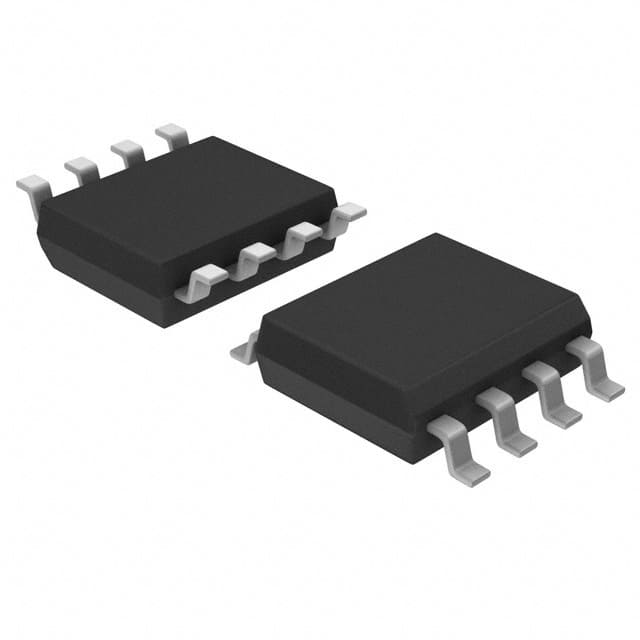M25PX80-VMN3TPB TR
Product Overview
Category
The M25PX80-VMN3TPB TR belongs to the category of non-volatile memory devices.
Use
This product is primarily used for data storage in various electronic devices such as computers, smartphones, and embedded systems.
Characteristics
- Non-volatile: The M25PX80-VMN3TPB TR retains stored data even when power is removed.
- High capacity: This device offers a storage capacity of 8 megabits (1 megabyte).
- Fast access time: The M25PX80-VMN3TPB TR provides quick read and write operations, ensuring efficient data transfer.
- Low power consumption: It is designed to consume minimal power during operation.
- Reliable: This memory device has a high endurance and can withstand multiple read/write cycles without data corruption.
Package and Quantity
The M25PX80-VMN3TPB TR is available in a compact surface-mount package. The exact packaging and quantity may vary depending on the manufacturer's specifications.
Specifications
- Memory Capacity: 8 megabits (1 megabyte)
- Interface: Serial Peripheral Interface (SPI)
- Supply Voltage: 2.7V - 3.6V
- Operating Temperature Range: -40°C to +85°C
- Data Retention: Up to 20 years
- Erase/Program Cycle Endurance: 100,000 cycles
Detailed Pin Configuration
The M25PX80-VMN3TPB TR follows a standard pin configuration for SPI memory devices:
- Chip Select (/CS)
- Serial Clock (SCLK)
- Serial Data Input (SI)
- Serial Data Output (SO)
- Write Protect (/WP)
- Ground (GND)
- Power Supply (VCC)
Functional Features
- High-speed data transfer: The M25PX80-VMN3TPB TR supports fast read and write operations, enabling efficient data handling.
- Sector-based erase and program: It allows selective erasure and programming of specific memory sectors, reducing unnecessary data modification.
- Write protection: The /WP pin can be used to protect the memory from accidental writes, ensuring data integrity.
- Software and hardware reset: This feature enables easy initialization and recovery of the device.
Advantages and Disadvantages
Advantages
- Large storage capacity
- Fast access time
- Low power consumption
- Reliable and durable
- Flexible sector-based operations
Disadvantages
- Limited compatibility with certain devices that do not support SPI interface
- Relatively higher cost compared to other memory technologies
Working Principles
The M25PX80-VMN3TPB TR utilizes flash memory technology for data storage. It employs a floating-gate transistor structure to store and retrieve digital information. When data is written, electrons are trapped in the floating gate, altering the transistor's conductive properties. These trapped charges represent the stored data. During read operations, the transistor's conductance is measured to determine the stored value.
Detailed Application Field Plans
The M25PX80-VMN3TPB TR finds applications in various fields, including:
- Consumer Electronics: Used in smartphones, tablets, digital cameras, and gaming consoles for data storage purposes.
- Automotive: Employed in automotive infotainment systems, instrument clusters, and navigation systems.
- Industrial Automation: Utilized in programmable logic controllers (PLCs), human-machine interfaces (HMIs), and industrial control systems.
- Medical Devices: Integrated into medical equipment such as patient monitors, diagnostic devices, and imaging systems.
- Internet of Things (IoT): Incorporated into IoT devices for storing sensor data, firmware updates, and configuration settings.
Detailed and Complete Alternative Models
- M25P16-VMN6TPB: 16 megabit (2 megabyte) capacity, similar characteristics and package.
- M25PX32-VMN6TPB: 32 megabit (4 megabyte) capacity, similar characteristics and package.
- M25PX64-VMN6TPB: 64 megabit (8 megabyte) capacity, similar characteristics and package.
These alternative models offer different storage capacities while maintaining similar features and compatibility with the M25PX80-VMN3TPB TR.
Word count: 570 words
Lista 10 Vanliga frågor och svar relaterade till tillämpningen av M25PX80-VMN3TPB TR i tekniska lösningar
Sure! Here are 10 common questions and answers related to the application of M25PX80-VMN3TPB TR in technical solutions:
Q: What is the M25PX80-VMN3TPB TR? A: The M25PX80-VMN3TPB TR is a serial NOR flash memory chip manufactured by Micron Technology.
Q: What is the storage capacity of the M25PX80-VMN3TPB TR? A: The M25PX80-VMN3TPB TR has a storage capacity of 8 megabits (1 megabyte).
Q: What is the interface used to communicate with the M25PX80-VMN3TPB TR? A: The M25PX80-VMN3TPB TR uses a standard Serial Peripheral Interface (SPI) for communication.
Q: What are some typical applications of the M25PX80-VMN3TPB TR? A: The M25PX80-VMN3TPB TR is commonly used in various applications such as automotive systems, industrial automation, consumer electronics, and IoT devices.
Q: What is the operating voltage range of the M25PX80-VMN3TPB TR? A: The M25PX80-VMN3TPB TR operates within a voltage range of 2.7V to 3.6V.
Q: What is the maximum data transfer rate supported by the M25PX80-VMN3TPB TR? A: The M25PX80-VMN3TPB TR supports a maximum data transfer rate of up to 104 MHz.
Q: Does the M25PX80-VMN3TPB TR support hardware and software write protection? A: Yes, the M25PX80-VMN3TPB TR supports both hardware and software write protection features.
Q: Can the M25PX80-VMN3TPB TR operate in extreme temperature conditions? A: Yes, the M25PX80-VMN3TPB TR is designed to operate within a wide temperature range of -40°C to +85°C.
Q: Does the M25PX80-VMN3TPB TR have any security features? A: Yes, the M25PX80-VMN3TPB TR offers various security features such as a unique device ID, one-time programmable (OTP) area, and password protection.
Q: Is the M25PX80-VMN3TPB TR RoHS compliant? A: Yes, the M25PX80-VMN3TPB TR is compliant with the Restriction of Hazardous Substances (RoHS) directive.
Please note that these answers are general and may vary depending on the specific implementation and requirements of your technical solution.


